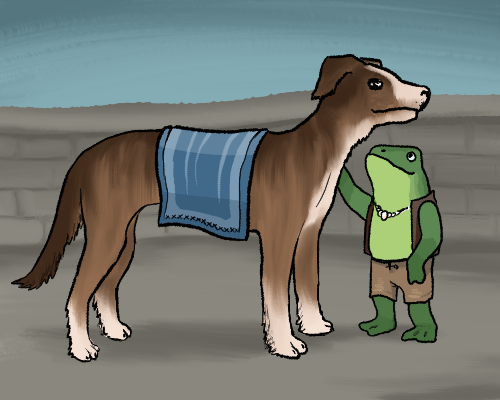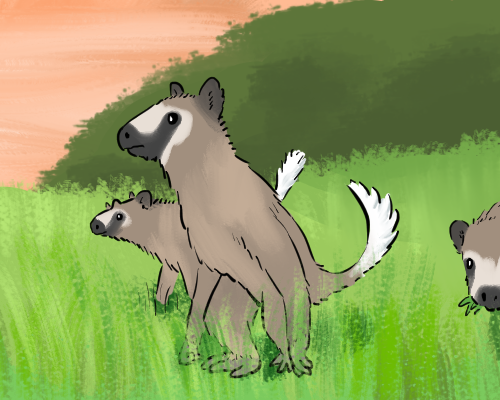Megafauna of Cordhan
An abridged field guide by B.T. Polistes
Cordhan is home to countless animal species, big and small. From the massive shrew-spiders of the western forests to the miniscule mites of the windswept cliffs, the land abounds with life. But there is one type that has captured the imagination of countless grubs, and that is megafauna. Generally defined as vertebrates of exceptional size, these beasts can trample entire bugkin outposts without even noticing, inciting both fear and awe while making them subjects of much study.
Reproduced here is a brief overview of some of Cordhan’s most notable and common megafauna. It is by no means exhaustive, and will be subject to updates and expansions as time goes on.

Packhounds are a species of domesticated mammal, kept as mounts and beasts of burden by mages across Cordhan. Descended from a now-rare species of plains-roaming hunters, they were the first species to be domesticated by mages and scarcely resemble their wild ancestors. Some breeds are used to draw carts and are thus bred for strength and endurance, while others are selected for pure speed. Still others are trained for work in poor climates, or to aid in hunting or fishing.
While extraordinarily useful, their carnivorous diet and high metabolism makes keeping even one an expensive prospect. Workers may rent one for a task or contribute to a communally-owned pair, but private ownership is generally restricted to nobles and wealthy merchants. Their temperament varies as much as their form, but they are social animals with a strong prey drive. Thankfully, most breeds lack the practical hunting skills required to support their great appetite and are thus rare outside of mage communities. One can assume that when a packhound is near, a mage is not far.

Stumpbeasts are a species of domesticated mammal, raised by mages for their meat and fur. The average mage only reaches the shoulder of these enormous animals, though males (called bulls) can grow even larger. They are primarily grazers but will supplement their diet with other plants if available. They are especially common in the western islands (which lack any predators large enough to threaten them) but they can be found in mountainous regions across Cordhan. While these grazers are bred to have a calm demeanor, bulls can be aggressive to other mammals and all stumpbeasts can become defensive if threatened. Their massive size and wide grazing range makes them a significant threat to outposts. While not as easily startled as smaller animals, they will flee from fire, so smoke or light-based methods can be used to ward them away.

Thistlebeasts are a taxa of wild mammals, common across the southwestern parts of Cordhan in small herds of three to six individuals. Like stumpbeasts, the males grow horn-like protrusions that demonstrate age and status in the herd, but are overall much smaller. These animals prefer leaves and shoots to grass, though they will feed on a wide range of vegetation as they migrate between forests and plains. Unlike their domesticated cousins, they are quick to flee, making deterrence relatively easy. Mages will often hunt them for their meat and pelts however, so caution should be taken during deterrence. Thankfully, sentry thistlebeasts produce a loud and startling noise upon sensing danger, which can be mimicked to send them running.

While most birds don’t grow large enough to be considered megafauna, there are some exceptions. Templebirds are the domesticated descendants of flightless birds native to an island to the far west of Cordhan, which were brought to the continent by merchants centuries ago. While lacking the strength and speed of packhounds, they’re sturdy enough to carry most riders and feed mostly on fish and vegetation. Not only does it make them cheaper to keep, but it permits them to be ridden in sacred grounds where carnivores are forbidden. This combined with their tolerance for rocky terrain made them excellent mounts for northern monks and priests, though their cleverness and stubborn temperament made them unpopular elsewhere. While generally cautious, their curiosity and large size makes them a danger to outposts. Playing recordings of predator calls may be enough to frighten them away, but stubborn individuals may continue to attack regardless. Use caution.

But when it comes to megafauna, the largest animals are rarely the most dangerous. It’s the smaller animals, ones that take interest in bugs, that pose the greatest danger. Setters are a taxa of reptiles known for their winding burrows (called setts) where they live in solitude. They are voracious insectivores that use their claws to tear apart nests of wild ants, termites, and ground-dwelling wasps, while their thick skin provides protection against stings and light weaponry alike. Curious and social animals, they are relentless in their pursuit and pose a grave threat to any bugkin who venture beyond the mountains. The various species of setters have adapted to numerous ecosystems in the hinterlands, making them unpredictable and adaptable foes. It is only through the tireless work of wildlife monitors and control agents that they are not found east of the mountains.
Last updated 9/20/24.
---~<*>~--~<*>~---~<*>~---
To return to the Cordhan index, click here.
To return to the homepage, click here.